Pacific Ocean Pollution: An In-Depth Analysis
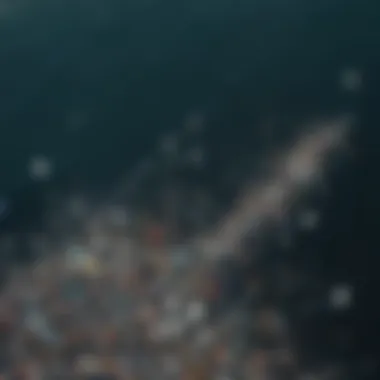
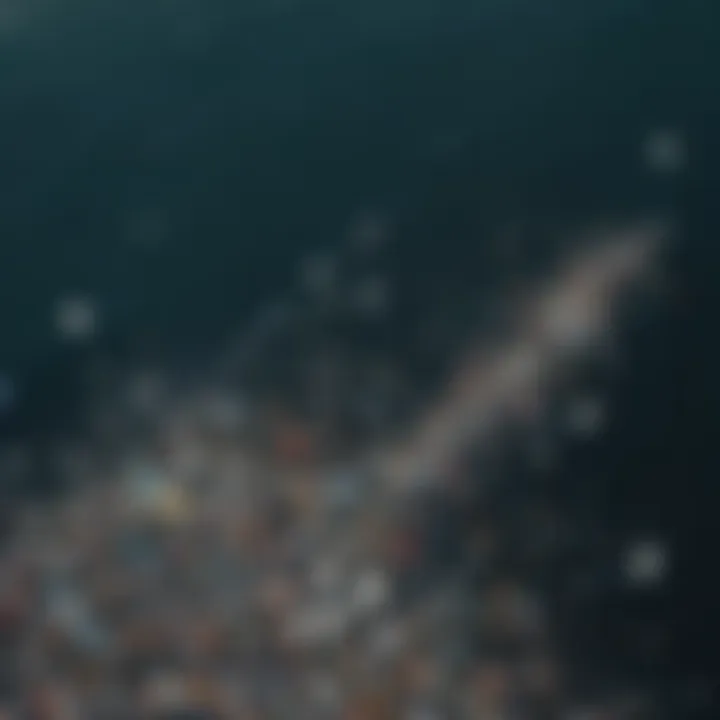
Intro
The Pacific Ocean, as the largest ocean on Earth, plays a crucial role in regulating climate and supporting marine biodiversity. However, pollution poses severe threats to this vast ecosystem. This comprehensive analysis aims to unpack the complexities of Pacific Ocean pollution by examining its sources, impacts, regulatory measures, and actions taken to mitigate this ongoing crisis. The narrative will illustrate how pollution not only shapes marine life but also adversely affects human populations dependent on these waters.
Key Concepts
Definition of Primary Terms
Pollution in the context of the Pacific Ocean refers to the introduction of harmful substances or contaminants that disrupt the natural balance of the marine environment. Key terms include:
- Marine Pollution: The introduction of harmful chemicals, waste materials, and other pollutants that degrade the quality of ocean water and affect marine life.
- Ecosystem Health: A measure of the state of the biological community, focusing on the resilience and functioning of marine ecosystems.
- Biomagnification: The process whereby the concentration of toxic substances increases with each level of the food chain, affecting larger marine animals.
Related Concepts and Theories
Understanding pollution in the Pacific Ocean requires frameworks to grasp its far-reaching impacts. Notable theories include:
- The Precautionary Principle: A strategy to cope with possible risks where scientific understanding is yet incomplete. It suggests erring on the side of caution in protecting marine ecosystems.
- Sustainability: This principle emphasizes the need for practices that meet current needs without compromising future generations' ability to meet theirs.
Sources of Pollution
Pollution in the Pacific Ocean emanates from several sources. Major contributors include:
- Plastic Waste: Millions of tons of plastic debris accumulate in the ocean, mainly from land-based activities. This leads to significant ecological harm, affecting species and habitats.
- Chemical Runoff: Pesticides and fertilizers used in agriculture wash into rivers, eventually reaching the ocean and causing eutrophication, which depletes oxygen levels.
- Marine Shipping: Increased shipping traffic across the Pacific introduces oil spills, ballast water contamination, and atmospheric emissions, all of which contribute to pollution.
- Industrial Discharges: Factories often release harmful waste directly into rivers, lakes, and coastal waters, leading to further contamination of marine ecosystems.
Impacts of Pollution
The fallout of pollution is felt across both marine ecosystems and human populations:
- Threat to Biodiversity: Marine species face habitat degradation, reproduction failures, and increased mortality rates.
- Human Health Risks: Contaminated seafood can lead to serious health risks, including mercury poisoning and exposure to harmful chemicals.
- Economic Consequences: Coastal communities that rely on fishing and tourism suffer economic losses due to reduced fish stocks and polluted beaches.
"Pollution in the Pacific Ocean has ripple effects, impacting not only the marine realm but also human societies connected to these waters."
Regulatory Frameworks
Efforts to combat pollution involve various regulatory measures. Global frameworks like the United Nations Convention on the Law of the Sea (UNCLOS) set guidelines for sustainable ocean governance. Organizations such as the Pacific Islands Forum focus on regional cooperation to address pollution through collaborative initiatives.
Ongoing Initiatives
Several initiatives are in place to tackle Pacific Ocean pollution:
- Clean-up Campaigns: Local and international organizations conduct marine clean-up operations to remove plastic debris from the ocean.
- Monitoring Programs: Research initiatives are established to track pollution levels and assess ecosystem health.
- Public Awareness Campaigns: Educating communities about sustainable practices aims to curb pollution at its source.
Future Directions
Gaps Identified in Current Research
Despite existing knowledge, gaps persist, particularly in understanding the long-term effects of microplastics on marine ecosystems. Researchers need to focus on coastal pollution’s socio-economic impacts as well.
Suggestions for Further Studies
Future studies should aim to:
- Investigate new filtration and recycling technologies for waste management.
- Explore the relationship between ocean pollution and climate change effects in the Pacific region.
This analysis brings to light the urgent need for enhanced attention towards pollution in the Pacific Ocean. From regulatory measures to community actions, addressing this crisis is critical for ensuring the health of our oceans and the well-being of future generations.
Prologue to Pacific Ocean Pollution
The Pacific Ocean is the largest and one of the most vital ecosystems on Earth. Its health is crucial for marine biodiversity, climate regulation, and even human livelihoods. The importance of this topic cannot be overstated. As pollution threatens these natural resources, it triggers a cascade of adverse effects that extend beyond the ocean itself. This article will explore the various types of pollution affecting the Pacific, the sources of these pollutants, and their implications for marine life and human health.
Overview of the Pacific Ocean
The Pacific Ocean spans more than 63 million square miles, covering roughly one-third of the Earth's surface. It is bordered by continents and islands, which makes it unique in terms of biodiversity and ecosystem functions. Features such as coral reefs, deep-sea habitats, and coastal wetlands contribute to its complex biological network. The ocean also plays a key role in regulating climate and weather patterns worldwide, as it absorbs carbon dioxide and produces much of the oxygen that humans rely on.
Challenges such as overfishing, habitat degradation, and climate change have long been recognized. However, pollution, particularly from plastic, chemicals, and excess nutrients, has become a pressing concern in recent decades.
Importance of Marine Ecosystems
Marine ecosystems offer numerous benefits to humanity and the planet. They are sources of food, livelihood, and recreation for millions. The vibrant coral reefs, for instance, support diverse species of fish and other marine life, creating rich habitats that are important for health of oceanic biodiversity.
Moreover, these ecosystems provide essential services such as carbon sequestration and natural coastal protection. Healthy oceans can mitigate the effects of climate change, producing oxygen and absorbing carbon dioxide effectively.
However, the pervasive threat of pollution diminishes these benefits. Pollutants not only harm marine organisms but also compromise the ecosystem's resilience. The decline of these ecosystems could lead to irreversible changes, affecting not just marine life but also human populations dependent on the ocean's resources.
"The health of the Pacific Ocean reflects the broader state of global environmental integrity."


In summary, understanding the importance of pollution in the Pacific Ocean is vital for defining conservation strategies and policies that can protect this critical resource for future generations. By examining specific pollutants and their sources, we gain insight into how we can formulate effective responses to this alarming crisis.
Types of Pollution Affecting the Pacific Ocean
The Pacific Ocean is significantly impacted by various types of pollution, each posing unique challenges to marine ecosystems and human health. Understanding these types provides crucial insights into mitigation efforts and the safeguarding of this vital resource. Awareness of pollution types is essential because each influences oceanic and coastal health differently. Addressing these concerns requires comprehensive knowledge and strategic approaches.
Plastic Pollution
Plastic pollution represents one of the most visible and pressing threats to the Pacific Ocean. Statistics show that millions of tons of plastic enter the ocean annually, causing harm to marine life and ecosystems. The most common forms include microplastics, fishing gear, and discarded items. Animals mistake these plastics for food, leading to ingestion that can be fatal.
The presence of plastics also affects habitats. Coral reefs, crucial for marine biodiversity, suffer from damage when covered in plastic debris. Repairing these ecosystems involves funding for cleanup and understanding the sources of plastic waste.
"More than 80% of marine litter originates from land-based sources, according to research."
Chemical Pollutants
Chemical pollutants are another significant factor. Pesticides, heavy metals, and industrial waste enter the ocean primarily through runoff. These chemicals can accumulate in marine organisms, causing health issues like reproductive failures and immune system disruptions.
In addition to harming aquatic life, there are direct implications for humans who consume contaminated seafood. Stricter regulations and monitoring are essential to control these pollutants. Understanding their pathways helps in creating better management strategies.
Oil Spills
Oil spills, while less frequent, create disastrous impacts when they occur. Events like the Exxon Valdez in 1989 showcase the long-term environmental devastation oil spills can cause. The oil coats the surface water, harming marine life and disrupting food chains.
Efforts to clean up oil spills are challenging and often take years, underscoring the need for preventive measures. Research into faster and more effective cleanup methods is ongoing.
Nutrient Loading
Nutrient loading, primarily from agricultural runoff, involves excessive nutrients entering the ocean. This can lead to harmful algal blooms, depleting oxygen levels and killing fish. The blooms disrupt the food chain and diminish water quality.
Addressing nutrient loading requires coordinated efforts between farmers, policymakers, and scientists. Sustainable agricultural practices can mitigate this source of pollution, improving both ocean and agricultural health.
Sources of Pollution in the Pacific Ocean
Understanding the sources of pollution in the Pacific Ocean is crucial for an effective response to this environmental challenge. Pollution does not originate solely from one area; it is a complex web of factors that can be traced to various human activities. Recognizing these sources helps in identifying the pathways pollutants travel through, which informs targeted actions to mitigate their effects. Each source contributes uniquely to the overall crisis, impacting marine ecosystems, human health, and even climate stability.
Land-Based Sources
Land-based sources represent a significant portion of pollution entering the Pacific Ocean. These include urban runoff, agricultural runoff, and industrial discharges. Urban runoff carries a mixture of debris, oils, heavy metals, and nutrients that flow into rivers and eventually the ocean. Agricultural runoff often introduces fertilizers and pesticides, which can lead to algal blooms, causing hypoxia and detriment to marine life.
Moreover, industrial discharges may contain harmful chemicals that not only pollute the water but also accumulate in the food chain. The cumulative effect of these substances can be drastic, leading to ecosystem disturbances and loss of biodiversity.
Marine Activities
Marine activities such as shipping, fishing, and tourism contribute heavily to ocean pollution. Shipping activities release ballast water, which can introduce invasive species and harmful pathogens. Additionally, oil spills, though less frequent, have devastating effects on marine life and habitats.
Fishing practices, particularly the use of driftnets and bottom trawling, can result in bycatch and habitat destruction. The presence of plastics from fishing gear is also a concern as it contributes to the growing plastic pollution crisis.
Atmospheric Deposition
Atmospheric deposition refers to the transfer of pollutants from the atmosphere to the ocean. This can occur through precipitation, where rain washes airborne toxic substances into the ocean. The sources of these atmospheric pollutants include industrial emissions, vehicle exhaust, and agricultural activities.
Consequently, heavy metals, persistent organic pollutants, and even drugs can be deposited into marine environments. This type of pollution often goes unnoticed but has significant and lasting effects on marine ecosystems. Understanding atmospheric deposition is essential to grasping how interlinked various pollution sources are.
"Tackling pollution requires understanding its sources, impacts, and the interconnected nature of human activities with the marine environment."
Impact of Pollution on Marine Life
The impact of pollution on marine life in the Pacific Ocean presents a serious concern. Marine ecosystems are intricate, with numerous species depending on each other for survival. As pollution levels rise, these relationships become strained. Pollution does not only harm individual species; it disrupts entire ecosystems. The repercussions extend to communities that rely on these waters for food, economic activities, and cultural practices. Understanding this impact is crucial for marine conservation and policy-making.
Threats to Biodiversity
Biodiversity in the Pacific Ocean faces several threats due to pollution. Distinct species often hold a unique role in their habitat. For instance, if a particular fish species suffers from chemical pollution, the consequences ripple through the food web, affecting other organisms that depend on it.
- Habitat Loss: Chemicals and waste can degrade habitats, leading to a decline in species populations.
- Invasiveness: Polluted waters may encourage the proliferation of invasive species that further outcompete native ones.
- Endangerment: Many marine species are already at risk due to pollution, contributing to their endangered status.
"The loss of biodiversity can destabilize ecosystems, which are vital for maintaining environmental health."
Effects on Fish Populations
Fish populations in the Pacific Ocean are significantly affected by pollution. Contaminated water can alter fish behavior and health. This impacts not just the fish themselves but also the larger predators that rely on them for food. Some specific effects include:
- Reduced Reproductive Success: Pollutants can influence hormone levels in fish, leading to diminished reproductive outcomes.
- Health Decline: The presence of toxins like heavy metals can impair fish health, leading to increased mortality rates.
- Changes in Migration Patterns: Fish may alter their migration paths to avoid polluted areas, disrupting traditional spawning sites.
Coral Reef Degradation
Coral reefs serve as one of the most delicate marine ecosystems. They are a critical linchpin for sustaining biodiversity in the Pacific Ocean. Pollution plays a major role in coral reef degradation:
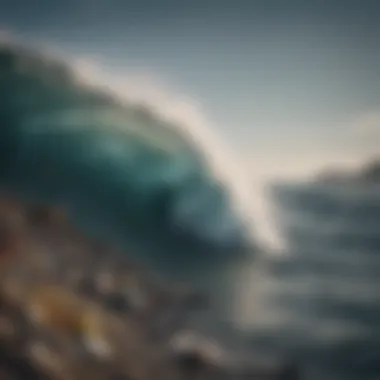
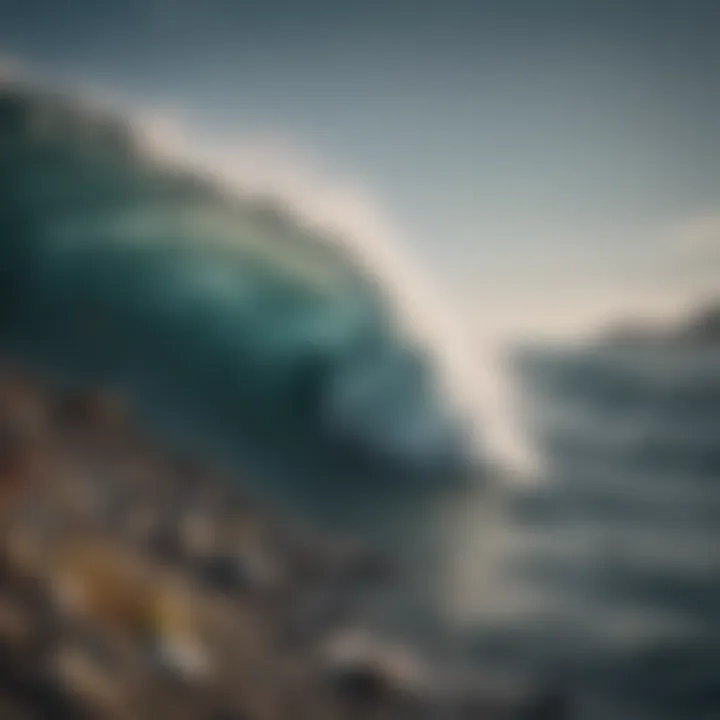
- Increased Water Temperature: Pollutants can contribute to higher sea temperatures, leading to coral bleaching. This process compromises coral health.
- Nutrient Runoff: Excess nutrients from agricultural runoff can promote the growth of harmful algal blooms, which block sunlight and suffocate corals.
- Physical Damage: Activities like shipping can lead to physical destruction of coral structures, making recovery more difficult.
Coral reefs not only provide habitat for various marine species but are also essential for coastal protection and tourism. Thus, preserving them is vital for both marine life and human economies.
Human Health Implications
The implications of pollution in the Pacific Ocean extend far beyond marine ecosystems. They significantly affect human health, particularly in coastal communities that rely on the ocean for sustenance, livelihood, and recreation. Understanding these consequences is crucial for advocating effective policies and community actions that aim to reduce exposure to ocean pollution.
Contamination of Seafood
Many people depend on seafood as a primary source of protein. Pollution introduces harmful substances into the marine food chain. Heavy metals like mercury and lead can accumulate in fish and shellfish, posing serious health risks to consumers.
- Bioaccumulation occurs when toxins build up in the tissues of marine organisms. As larger fish consume smaller fish, the concentration of these toxins increases.
- Health Risks associated with contaminated seafood include neurological and developmental problems, particularly in children and pregnant women. These risks underscore the need for stringent monitoring of seafood safety to protect public health.
Water Quality Issues
Water quality is directly related to human health. Pollution, including sewage and industrial waste, can lead to contamination of drinking water supplies and recreational waters. This contamination jeopardizes public health by increasing the prevalence of waterborne diseases.
- Pathogens from human and animal waste can thrive in polluted waters, leading to illnesses such as cholera and gastroenteritis.
- Chemical contaminants, including pesticides and pharmaceuticals, can also enter drinking water sources, contributing to various health issues, from hormonal disruptions to cancer risks.
Public Health Risks
The broader public health risks associated with Pacific Ocean pollution warrant serious consideration. Coastal communities are often the most affected.
- Mental Health Impact: The decline of local fisheries and marine resources can lead to economic instability. This stress can adversely affect mental health among those who depend on these resources.
- Social Justice Issues: Vulnerable populations are disproportionately affected by the health impacts of pollution. Access to clean water and safe seafood should be universal, yet socio-economic factors often dictate exposure.
Addressing these public health risks requires a multi-faceted approach. Collaborative efforts between governments, researchers, and local communities are essential to implement effective solutions to reduce exposure to ocean pollutants.
In summary, the ramifications of pollution in the Pacific Ocean on human health cannot be ignored. Contaminated seafood, poor water quality, and associated public health risks highlight the urgency of addressing these issues. Awareness, education, and policy change are vital steps toward ensuring a healthier future for both marine life and human populations.
Regulatory Frameworks and Policies
The management of pollution in the Pacific Ocean cannot be effectively addressed without a robust framework of regulations and policies. This framework facilitates cooperation among countries, organizations, and local agencies to confront the pressing issues of pollution and safeguard marine ecosystems.
Regulatory frameworks play a significant role in outlining responsibilities and legal obligations concerning pollution prevention and reduction. Their implementation helps to reduce marine pollution through structured approaches and enforceable actions. Below are key elements and benefits of having established frameworks governing pollution management in the Pacific Ocean.
- Setting Standards: Regulations provide measurable standards for pollution levels, helping to monitor and control contaminants.
- International Cooperation: Treaties and agreements promote collaboration, ensuring countries work together to address pollution that crosses national boundaries.
- Public Accountability: Policies increase transparency, allowing for public scrutiny of governmental and corporate actions regarding environmental protection.
- Funding and Resources: Governmental regulations often allocate funding for research and technological development that aids in pollution management.
- Ecosystem Protection: Effective policies ensure the sustainability of marine ecosystems, thereby preserving biodiversity and the health of the ocean.
International Treaties
International treaties have great importance in the context of Pacific Ocean pollution. These agreements formalize commitments made by nations to manage and mitigate pollution. A number of treaties stand out in the global effort to protect marine environments:
- The MARPOL Convention: This treaty aims to prevent pollution from ships by regulating waste discharge and controlling oil spills.
- The United Nations Convention on the Law of the Sea (UNCLOS): This convention establishes guidelines for the use of ocean resources and the responsibilities of nations concerning marine conservation.
- The Basel Convention: This treaty addresses the movement of hazardous waste and aims to minimize waste generation and disposal.
The effectiveness of these international agreements often depends on the cooperation among countries. Violations can lead to sanctions or penalties, but the collaborative spirit is typically more fruitful in achieving long-term goals.
Local Governance Efforts
While international treaties lay the groundwork, local governance efforts are crucial for implementing policies on the ground. Municipal and regional authorities often take the lead in addressing localized pollution issues that may not be covered by broader treaties. Examples of local governance strategies include:
- Establishing Marine Protected Areas: These zones limit human activity to protect habitats and ecosystems, allowing them to recover from pollution.
- Water Quality Regulations: Local agencies can set specific limits on pollutants and monitor water sources to ensure compliance.
- Community Engagement: Local governments often promote public awareness campaigns and educational programs to engage communities in pollution reduction efforts.
Ongoing Conservation Efforts
Ongoing conservation efforts are crucial to address the pollution crisis facing the Pacific Ocean. This section discusses current strategies that aim to mitigate the adverse effects of pollution on marine ecosystems and ensure a sustainable future for this vital ocean. By highlighting initiatives such as marine protected areas, cleanup operations, and community involvement, it illustrates how a multi-faceted approach is essential for real progress.
Marine Protected Areas
Marine protected areas (MPAs) serve as sanctuaries for diverse marine life. They limit human activities like fishing, mining, and shipping in designated zones, allowing ecosystems to recover from pollution and overexploitation. The establishment of MPAs encourages biodiversity, protects vital habitats, and contributes to the resilience of marine species. Research indicates that MPAs can lead to increased fish populations, healthier coral reefs, and overall better ocean health.
It is vital to ensure that MPAs are effectively managed. Continuous monitoring and enforcement of regulations is necessary for their success. Collaboration among governments, scientists, and conservationists strengthens these efforts, providing financial and technical resources.
Cleanup Initiatives
Various cleanup initiatives target pollution directly. Programs focus on removing debris from coastlines and open ocean regions. Initiatives like the Ocean Cleanup Project aim to utilize new technologies to reduce the amount of plastic in the ocean. Their innovative systems are designed to capture debris as it drifts, preventing harm to marine animals.
Local community efforts play a significant role in these cleanups. Organizing beach cleanups not only removes waste but also raises awareness among participants. The involvement of volunteers empowers communities to take ownership of their environment. These efforts collectively contribute to cleaner oceans and healthier marine habitats.
Community Involvement
Community involvement is vital in the fight against Pacific Ocean pollution. Grassroots movements are essential. Local populations understand their environments best and can advocate for policies that protect marine resources. Community-led initiatives often focus on education, helping residents understand the impacts of pollution and encouraging sustainable practices.
Collaboration with non-profit organizations can amplify these efforts. For example, programs that educate schools and businesses about waste reduction and responsible consumer behavior create a ripple effect, spreading knowledge throughout communities.
"Local engagement is key to successful conservation. When communities take part in protecting their oceans, they foster stewardship and responsibility for future generations."
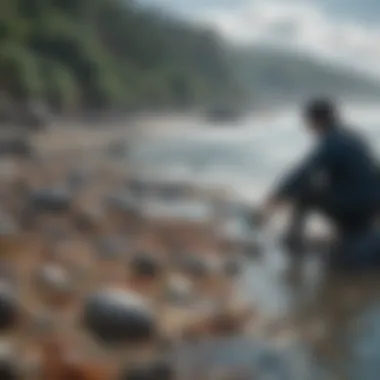

Technological Innovations in Pollution Management
Technological innovations play a critical role in addressing the complexities of pollution in the Pacific Ocean. These advancements not only facilitate monitoring and assessment but also offer solutions for cleaning and managing marine pollution. Understanding these technologies is essential for developing effective strategies to combat pollution, safeguard marine ecosystems, and promote sustainable practices.
Monitoring Technologies
Monitoring technologies are essential for understanding the extent and nature of pollution in the Pacific Ocean. These tools can include satellite imagery, drones, and underwater sensors.
- Satellite Imagery: This technology allows researchers to track changes in ocean color, which can indicate algal blooms or sedimentation caused by pollution. By utilizing satellite data, scientists can monitor wide areas of the ocean efficiently and gather valuable information on pollution patterns over time.
- Drones: Drones equipped with cameras and sensors can survey coastal areas and collect real-time data on pollution levels. They offer a cost-effective way to gather data in hard-to-reach regions, allowing for timely assessments.
- Underwater Sensors: These devices can monitor water quality parameters such as temperature, salinity, pH, and contaminant levels. Continuous data collection helps identify pollution sources and assess the health of marine ecosystems.
"Effective monitoring technologies are the foundation for informed decision-making regarding ocean conservation efforts."
The significance of these monitoring technologies lies in their ability to produce comprehensive datasets that inform policymakers, researchers, and the public about the state of the ocean and the effectiveness of pollution control measures.
Bioremediation Strategies
Bioremediation strategies utilize living organisms to remove or neutralize contaminants from the environment. This approach offers an eco-friendly alternative to traditional cleaning methods, minimizing environmental collateral damage. Two significant bioremediation methods include:
- Microbial Bioremediation: This technique employs bacteria or microorganisms to degrade pollutants into less harmful substances. Some microbes can break down oil spills or plastic waste, making them vital in cleaning polluted marine areas.
- Phytoremediation: This method uses plants to absorb, accumulate, and detoxify contaminants from soil and water. Certain plant species have shown potential in filtering out heavy metals and other pollutants from marine environments.
The advantages of bioremediation include sustainability, cost-effectiveness, and the reduction of hazardous materials without introducing further pollution. These strategies can be integrated into broader pollution management efforts to enhance restoration efforts in the Pacific Ocean.
Public Awareness and Education
Public awareness and education play crucial roles in addressing pollution in the Pacific Ocean. Understanding the extent and implications of pollution is vital for inspiring action among communities and policymakers alike. Knowledge empowers individuals to make informed decisions regarding their behaviors that impact our oceans. By fostering a culture of environmental respect, we can encourage sustainable practices that benefit both marine ecosystems and human populations.
Role of Education in Mitigation
Education serves as a foundation for mitigation efforts against Pacific Ocean pollution. Providing comprehensive information about the challenges faced by marine environments can shape public attitudes and behaviors. Schools and universities can introduce programs focused on marine science, ecology, and environmental ethics, which equip students with knowledge about the consequences of pollution.
When young people learn about the interconnectedness of human activity and ocean health, they become advocates for change. Moreover, educational institutions can collaborate with organizations that specialize in marine cleanup, allowing students to engage in hands-on experiences. This not only increases awareness but also builds a sense of responsibility towards environmental stewardship.
Campaigns for Change
Campaigns for change are essential in mobilizing public support and action against pollution in the Pacific Ocean. These initiatives often make use of digital and social media platforms, allowing information to spread quickly and widely. Campaigns can focus on various aspects, such as reducing plastic usage, promoting recycling, and participating in local clean-up events.
Organizations like the Ocean Conservancy and Surfrider Foundation have been instrumental in implementing such campaigns. They create community events that invite participation and educate the public about the dangers of ocean pollution.
The effectiveness of these campaigns can be measured by changes in behavior. When communities rally around a cause, it fosters a collective responsibility for ocean health. The promotion of eco-friendly products and practices can lead to widespread changes in how individuals approach their daily lives.
"Public engagement and education remain paramount for the future health of our oceans. Without them, effective mitigation strategies can only go so far."
Through consistent public awareness efforts and educational initiatives, it is possible to cultivate a population that not only understands the importance of preserving marine ecosystems but also takes proactive steps in safeguarding the Pacific Ocean for future generations.
Future Directions for Research
Research into Pacific Ocean pollution is vital for creating effective strategies to mitigate its effects. Understanding current trends and identifying gaps in knowledge can inform future policies and conservation efforts. Areas deserving attention include the identification of emerging contaminants and the necessity for longitudinal studies on impacts.
Emerging Contaminants
Emerging contaminants represent substances that are increasingly detected in marine environments, yet their effects are not fully understood. These may include pharmaceuticals, personal care products, and microplastics that are smaller than 5mm. Their presence raises questions about bioaccumulation and potential toxicity for marine organisms and human consumers.
Several studies are pointing to the harmful effects of these compounds on aquatic life. For instance, trastuzumab, a cancer drug, has been found in trace amounts in marine ecosystems, showing that pharmaceuticals can find pathways into the ocean. Understanding the gradients of pollution and the overall distribution of these emerging substances is essential. This requires innovative sampling techniques, advanced chemical analysis methods, and more robust data collection mechanisms.
Addressing this field in research can lead to better regulatory measures which dictate how such contaminant releases can be mitigated, thus preserving marine health and protecting public safety. Future research should also focus on the ecological ramifications of these contaminants to understand their full impact on biodiversity.
Longitudinal Studies on Impact
Longitudinal studies involve repeated observations of the same variables over long periods and are crucial for understanding the long-term impacts of pollutants on the Pacific Ocean. Research shows that pollutants in the ocean can contribute to shifts in marine species distribution, reductions in biodiversity, and alterations in ecosystem functions.
By monitoring specific sites over time, scientists can identify trends and develop models to predict future scenarios under various pollution scenarios. For example, observing fish populations over time can help measure the effects of persistent toxins. This type of research can also reveal how resilient marine ecosystems are to pollution and can provide evidence needed for policy-making.
In addition, these studies can allow for the assessment of restoration efforts in pollution-impacted areas, offering insights into what strategies are most effective. Understanding temporal changes also aids in public awareness and education, highlighting how ocean health correlates with human health and encouraging community-driven conservation efforts.
Closure
The conclusion of this article serves not just as a recapitulation of key elements regarding Pacific Ocean pollution but as a critical reflection on the implications for future stewardship of marine ecosystems. Given the diverse and multifaceted challenges that pollution presents to the Pacific, understanding the significance of these issues is essential for effective problem-solving.
Summary of Key Findings
Throughout this exploration, several key findings stand out regarding pollution in the Pacific Ocean:
- Diverse Sources: Pollution arises from various sources, including land-based runoff, industrial discharge, and maritime activities, leading to an accumulation of pollutants in ocean depths.
- Impact on Marine Life: The ecological consequences extend far beyond mere visibility; they threaten biodiversity, disrupt food chains, and imperil vulnerable species such as coral reefs and fish populations.
- Human Health Risks: Polluted oceans pose health risks to humans, primarily through the consumption of contaminated seafood and compromised water quality, highlighting an urgent need for better regulatory measures.
- Regulatory Frameworks: Multiple global and local initiatives aim to tackle these issues. However, gaps remain in enforcement and adherence, suggesting a need for renewed attention on implementation and effectiveness.
- Conservation Efforts: Ongoing initiatives, like establishing Marine Protected Areas, showcase proactive steps toward rehabilitation and protection of marine environments but require greater community involvement and awareness.
By synthesizing these findings, it becomes clear that the issue of pollution is systemic and interconnected, demanding comprehensive organizational and individual actions.
Call to Action for Stakeholders
In light of the findings, it is increasingly evident that stakeholders across various sectors must engage collectively to confront the challenges presented by pollution in the Pacific Ocean. The following actions are paramount:
- Enhance Collaboration: Governments, researchers, and NGOs need to collaborate in research efforts aimed at understanding pollutants and their effects comprehensively. Fostering partnerships can leverage resources and knowledge effectively.
- Increase Public Awareness: Educational initiatives that inform the public about the sources and consequences of pollution are imperative. Engaging communities in conservation efforts is equally crucial for creating sustainable practices.
- Strengthen Regulations: Policymakers must evaluate and fortify existing frameworks. This includes closing loopholes in enforcement and making regulatory policies more stringent to protect marine environments.
- Invest in Technology: Promoting technological innovations in monitoring and pollution management can yield significant benefits in tracking pollution sources and mitigating their effects.
- Promote Sustainable Practices: Businesses and industries have a responsibility to adopt environmentally friendly practices. Emphasizing sustainability in production processes can directly reduce ocean pollution.
In summary, while the problem of Pacific Ocean pollution is daunting, the pathways toward remediation and protection lay in a collective effort that involves all stakeholders. Immediate action is essential for the health of our oceans and, consequently, our planet.



